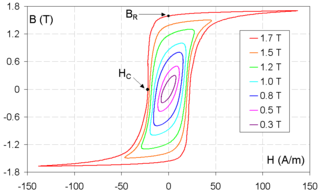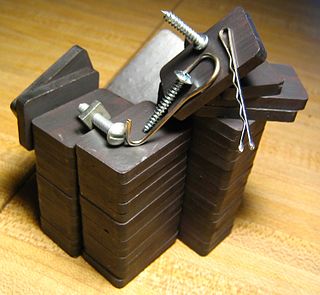

The Soft Magnetic Materials Conference, commonly referred to as SMM, is an international conference devoted to all kinds of soft magnetic materials with the emphasis on industrial and applications aspects.


The Soft Magnetic Materials Conference, commonly referred to as SMM, is an international conference devoted to all kinds of soft magnetic materials with the emphasis on industrial and applications aspects.
The SMM is held for three days, every two years, often at the beginning of September in a European country. Each time the SMM has a different logo.
In SMM18 (organised by Wolfson Centre for Magnetics there were 260 participants from over 30 countries. There were 306 scientific papers presented, out of which around 200 are peer reviewed and will be published in Journal of Magnetism and Magnetic Materials, Elsevier at the beginning of 2008.
In the past the SMM proceedings have also been published in IEEE Transactions on Magnetics [1] or other peer reviewed journals. [2]
The SMM is the largest international conference devoted to soft magnetic materials. It has active participation of the academic world as well as of industry, with a high scientific level of contributed and invited communications. [3]
The main aim of the SMM is to bring together engineers and scientists from universities, research institutions and industry who are active in research, development and industrial applications of the materials. The programme of the conference includes invited lectures by academic and industrial experts, oral presentations and poster sessions for regular contributions.
Typical topics of the SMM are:
The conference series has an International Organising Committee, chaired by I. Škorvánek of Košice, Slovakia. The previous chairs were J.M. Barandiaran, of Bilbao, Spain, Anthony J. Moses, of Cardiff, UK, Fausto Fiorillo, of Turin, Italy, and John E. Thompson who was the founder chair.
For each SMM there is a Local Organising Committee (academic and research members of staff of the local university), which is responsible for local arrangements, venue, technical programme, conference dinner, etc.

A magnet is a material or object that produces a magnetic field. This magnetic field is invisible but is responsible for the most notable property of a magnet: a force that pulls on other ferromagnetic materials, such as iron, steel, nickel, cobalt, etc. and attracts or repels other magnets.
The oersted is the coherent derived unit of the auxiliary magnetic field H in the centimetre–gram–second system of units (CGS). It is equivalent to 1 dyne per maxwell.

Coercivity, also called the magnetic coercivity, coercive field or coercive force, is a measure of the ability of a ferromagnetic material to withstand an external magnetic field without becoming demagnetized. Coercivity is usually measured in oersted or ampere/meter units and is denoted HC.

A Halbach array is a special arrangement of permanent magnets that augments the magnetic field on one side of the array while cancelling the field to near zero on the other side. This is achieved by having a spatially rotating pattern of magnetisation.

Alnico is a family of iron alloys which, in addition to iron are composed primarily of aluminium (Al), nickel (Ni), and cobalt (Co), hence the acronym al-ni-co. They also include copper, and sometimes titanium. Alnico alloys are ferromagnetic, and are used to make permanent magnets. Before the development of rare-earth magnets in the 1970s, they were the strongest permanent magnet type. Other trade names for alloys in this family are: Alni, Alcomax, Hycomax, Columax, and Ticonal.

The Polytechnic University of Turin is the oldest Italian public technical university. The university offers several courses in the fields of Engineering, Architecture, Urban Planning and Industrial Design, and is consistently ranked as one of the best universities in Italy and in the world. As of 2024, it is ranked 28th worldwide for Mechanical Engineering, 22nd for Petroleum Engineering, 21st for Architecture and is among the top 100 (52nd) engineering and technology universities in the world.

Galileo Ferraris was an Italian university professor, physicist and electrical engineer, one of the pioneers of AC power system and inventor of the induction motor although he never patented his work. Many newspapers touted that his work on the induction motor and power transmission systems were some of the greatest inventions of all ages. He published an extensive and complete monograph on the experimental results obtained with open-circuit transformers of the type designed by the power engineers Lucien Gaulard and John Dixon Gibbs.

A ferrite is one of a family of iron oxide-containing magnetic ceramic materials. They are ferrimagnetic, meaning they are attracted by magnetic fields and can be magnetized to become permanent magnets. Unlike many ferromagnetic materials, most ferrites are not electrically conductive, making them useful in applications like magnetic cores for transformers to suppress eddy currents.
The 1964–65 season of the European Cup Winners' Cup club football tournament was won by West Ham United in a final at Wembley Stadium against 1860 Munich. West Ham's Bobby Moore captained a side that also included Geoff Hurst and Martin Peters just one season before all three went on to star in England's World-Cup-winning side of 1966. As a result of their CWC success, Bobby Moore became the only captain to climb the Wembley steps to be presented with three different trophies in three successive seasons.

Wolfson Centre for Magnetics (WCM) is a research and knowledge centre operating within School of Engineering at Cardiff University.
John Michael David Coey, known as Michael Coey, is a Belfast-born experimental physicist working in the fields of magnetism and spintronics. He is an Emeritus professor at the Trinity College Dublin (TCD).

Philip Beckley is a British physicist, author, and lecturer.
International Workshop on 1 & 2 Dimensional Magnetic Measurement and Testing - international meeting devoted to problems in one- and two-directional magnetisation of ferromagnetic materials.

The switched reluctance motor (SRM) is a type of reluctance motor. Unlike brushed DC motors, power is delivered to windings in the stator (case) rather than the rotor. This simplifies mechanical design because power does not have to be delivered to the moving rotor, which eliminates the need for a commutator. However it complicates the electrical design, because a switching system must deliver power to the different windings and limit torque ripple. Sources disagree on whether it is a type of stepper motor.

Anthony John Moses is a Welsh scientist, researcher and professor, former director of Wolfson Centre for Magnetics.
Shamkant B. Navathe is a noted researcher in the field of databases with more than 150 publications on different topics in the area of databases.
Magnonics is an emerging field of modern magnetism, which can be considered a sub-field of modern solid state physics. Magnonics combines the study of waves and magnetism. Its main aim is to investigate the behaviour of spin waves in nano-structure elements. In essence, spin waves are a propagating re-ordering of the magnetisation in a material and arise from the precession of magnetic moments. Magnetic moments arise from the orbital and spin moments of the electron, most often it is this spin moment that contributes to the net magnetic moment.
Dr. Arcady P. Zhukov is a research professor or Russian origin, currently working in Spain.

Laura Henderson Lewis is an American electronic materials scientist and engineer. She is a distinguished university professor at Northeastern University, having previously served as the department chair of Northeastern University's chemical engineering department. Prior to her Northeastern University position, she was a research group leader and associate department chair in the nanoscience department of Brookhaven National Laboratory (BNL).
Bernard Dieny is a research scientist and an entrepreneur. He is Chief Scientist at SPINTEC, a CEA/CNRS/UGA research laboratory that he co-founded in 2002 in Grenoble, France. He is also co-founder of two startup companies: Crocus Technology on MRAM and magnetic sensors in 2006 and EVADERIS on circuits design in 2014.